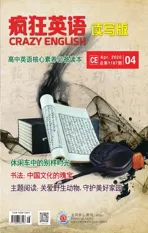Calligraphy,the gem of Chinese culture
2020-06-03GuoJiulin
Guo Jiulin
Calligraphy is something very special for Chinese. It is not only an important part of traditional Chinese culture but also a way of life for people of all stripes. Rarely does any other culture in human history fascinate with calligraphy in such a profound way. From the invention of hieroglyphics (象形文字) to the evolution of various calligraphic scripts, calligraphy has played a critical role in Chinese culture and history for thousands of years.
Calligraphy was well-respected in history. It was a foundation for scarcely available education opportunities and a steppingstone to become the elite class. In essence, calligraphy is also the cultural identity and the manifestation of collective aesthetic (美学的) philosophy. During Jin Dynasty (AD 265—420), calligraphy became an expression of superiority among noble families. The rivalries (竞争) were so intense that young children were ordered to receive extensive training in calligraphy.
Wang Xizhi was among those raised in noble families. Along with his son, Wang Xianzhi,the Wangs were considered the greatest calligraphers in Chinese history. Therefore, Jin Dynasty is a Golden Age of calligraphy works in Chinese history.
In Tang Dynasty (AD 618—907), the Emperor Taizong not only revered (尊敬) Wang Xizhi's calligraphy, but himself was also good at it. He considered Wang Xizhi as the greatest calligrapher in history. His obsession with Wang Xizhi made him promote his subordinates(属下)based on their talent for mimicking Wang's works. Prizing Wang's works as his priceless treasure, the emperor kept them only for his most trusted subordinates and, after his death,he was buried along with Wang's works. Not surprisingly, Tang Dynasty was another Golden Age of Chinese calligraphy. A generation of great calligraphers, such as Ouyang Xun, Yu Shinan, Chu Suiliang, Yan Zhenqing, Sun Guoting, Liu Gongquan and many others, emerged,whose calligraphic works also became masterpieces for later generations to emulate.
Calligraphy used to be a privilege among the well-educated elites. Nowadays, significant reductions in poverty and illiteracy encourage more and more people to practice calligraphy.As much as recreation, physical fitness and artistic appreciation, calligraphy is becoming a part of life among many Chinese people. With numerous calligraphy training courses and interest groups among local schools and communities,plus various calligraphic competitions, exhibitions and auctions, today is another Golden Age of Chinese calligraphy.
Critical thinking
How many Golden Ages of Chinese calligraphy are mentioned in the text? What are they?
